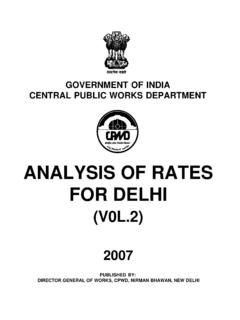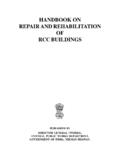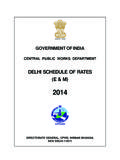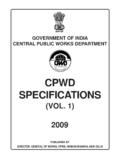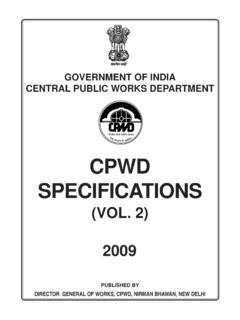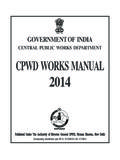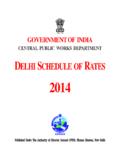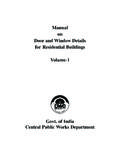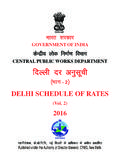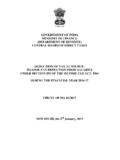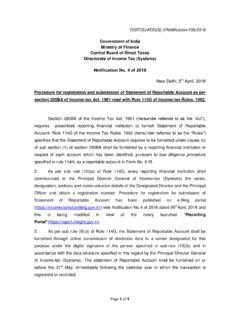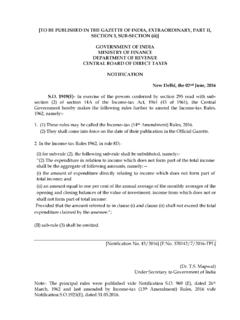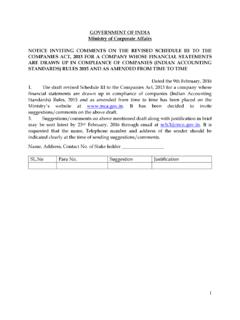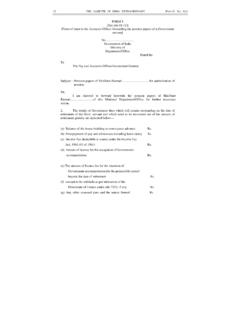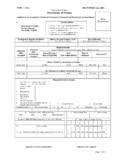Transcription of GUIDE LINES - Central Public Works Department, …
1 FOR OFFICIAL USE ONLY. GUIDE LINES . FOR VALUATION OF. IMMOVABLE PROPERTIES. VALUATION CELL. income TAX DEPARTMENT. ministry OF FINANCE. government OF india . 2009. SAROJ BALA, Member (Revenue) & Ex-officio Additional Secretary to the government of india Department of Revenue ministry of Finance government of india New Delhi 110001. MESSAGE. I greatly value the collective efforts of entire Valuation cell Team to have come up with this much awaited compendium on the subject of valuation of immovable properties. This compilation contains all the relevant material and updated guidelines on the subject of valuation covering its various legal and procedural aspects. I am sure that book on Guidelines for Valuation of Immovable Properties will be of great use to the Valuation Officers as well as income Tax Authorities in estimating the value of immovable properties as required by the tax statutes uniformly throughout the country.
2 (Saroj Bala). SACHDEV. Director General ( Works ). Central Public Works Department Nirman Bhawan New Delhi-110011. MESSAGE. I am happy to note that Shri D. Hore, Chief Engineer (Valuation) NR, New Delhi, alongwith his team of officers has brought out a book Guidelines for Valuation of Immovable Properties , covering various legal and procedural aspects of valuation. Earlier also Valuation Cell had brought out publications from time to time. The Valuation Officers have to perform techno-legal functions which are entirely different from the normal activity of CPWD. When the offices from CPWD joined the Valuation Unit of , they have to acquaint themselves with the procedure for valuation of properties. This compilation will go a long way in proper appreciation of the rules and regulations relating to the valuation of fixed assets. I hope that the book would be updated from time to time, in the light of the modification of Acts and interpretation of Acts by the Courts.
3 ( Sachdev). OFFICE OF THE CHIEF ENGINEER (VALUATION). NORTHERN REGION. income TAX DEPARTMENT. 11TH FLOOR, 3 TOLSTOY MARG, NEW DELHI-110001. Telephone No. 011 23313693, 23730726. FOREWORD. income Tax including Capital Gains, Wealth Tax and Gift Tax are the direct taxes levied by Govt. of india . Any person having a property has to prove its valuation under the provisions of those taxes whenever the property is built, purchased, sold, inherited or gifted. To prevent undervaluation of land and building for tax evasion, valuation cell was created in 1968. The objective was to assist the assessing officers to ensure proper valuation of the properties for tax realizations. Initially it functioned as an advisory committee. The Valuation Cell in the present form was set up in 1972. In Taxation Law (Amendment) Act 1972 provisions for reference to Valuation Officers were made under sections 16A of Act, 55A of Act and 15(6) of Gift Tax Act with effect from Under these acts Valuation Officers were vested with statutory powers.
4 Valuation Cell had been quite effective in generating additional revenue. Further, its presence acts as a deterrent as would be evident from the PAC. report of 1990-91. ------- In purely technical sense the Valuation Cell is not only cost effective, but also there were other intangible benefits such as the tax paying Public know that their property values are susceptible to verification by the Cell."---------- With a view to adopt uniformity in preparation of valuation reports by Valuation Officers, guidelines were prepared by Shri A. Chattopadhyaya, Chief Engineer (Valuation), (North), New Delhi during October 1996, and were circulated in the Northern Region. Similarly Shri Dhawan, Chief Engineer (Valuation), Southern Region issued the guidelines during September-1999 and circulated to the Valuation Officers of the Southern Region. Thus the Valuation Cell of the Department has been following Guidelines for valuation of immovable Foreword properties which were defined long back.
5 After theses guidelines were laid down, there have been several changes in the related acts. Incorporating these changes and clarifying other issues various detailed instructions were issued by Shri Majumdar, the then (Val.), Northern Region during 2005-2007 for the Valuation Officers while evaluating the cost of the property. Similarly CE (Valuation) Southern Region also issued instructions from time to time. Considering all above it was felt that there is a dire need to issue updated guidelines, owing to modifications in the tax rules and multiplicities of various instructions issued on the subject. It was also found necessary that same guidelines are followed by the officers in the Valuation Cell irrespective of the regions. Shri Singh, Chief Engineer (Valuation) Northern Region (Now ADG, NR), took a lead and with a view to compile updated guidelines and requested the Chief Engineer (Valuation) (Southern Region) and District Valuation Officers of both Northern Region & Southern Region to offer their comments on the existing guidelines and the instructions issued from time to time by respective Chief Engineers, (Valuation).
6 The arduous task of compiling the earlier guidelines, incorporating the instructions issued from time to time by the CEs, and the suggestions received from various DVOs, was entrusted to Shri Ravi Kant Soni, District Valuation Officer, Jaipur. The suggestions received from the CE (Val.) ( ) and DVOs were compiled by hectic efforts by Shri Ravi Kant Soni, DVO and the draft book was finalized, which incorporates all feasible modifications and it has the blend of experience gained during the intervening period also. The draft book was circulated to CE (Valuation) Southern Region and all DVOs under Northern & Southern Regions. The valuation suggestions were received from Shri Padamnabhan, Chief Engineer (Valuation). Southern Region. In a meeting held in the chamber of Chief Engineer (Valuation) Northern Region during January 2009 the suggestions given by various District Valuation Officers were discussed and suitably incorporated.
7 This book containing guidelines, supersedes, all instructions as well as Guidelines for Valuation of Immovable Property issued till date in this regard. It is also mentioned, that these Guidelines for Valuation of Immovable Property shall be effective for all the Valuation Cells under Foreword the entire jurisdictions of Northern Region as well as Southern Region. Thus these Guidelines would help the technical experts towards familiarization with the techno-legal requirement of the Works of the Valuation Cell and to adopt correct and uniform methods of valuation. In valuation money value attributed to an asset is ascertained. It is difficult to have an exact value as certain amount of assumption is inevitable in the process. The assumption must however be an intelligent one based on certain objective factors derived after scientific analysis of available data.
8 The valuer has to apply his own judgment depending upon the prevailing conditions and choose the most appropriate method and value. In most cases assessee goes for appeal whenever valuation leads to increased tax liabilities. Therefore the real worth of a valuation is evident only after the test of appeals. In appeals the assessee musters private valuers, engineers, lawyers etc. for his defense. To prove that the valuation declared by the assessee is not correct, Valuation Officer has to thoroughly study the documents of the assessee, make thorough investigation and collect data. Then he has to establish the correctness and suitability of the methods of valuation adopted by him and correctness of the data relied upon by him. The valuation report should explain the reasons for which it is of different amount than the declared value so that the appellate authorities can appreciate.
9 Investigation and collection of data are therefore very important. For this Valuation Officer has to freely interact with local people also. The Valuation Officer has to convince the Appellate Authority who are not conversant in technical matters. This makes his work more challenging. Preparation of valuation report is an important part of his assignment. Conducting it through appeals unscathed is equally important. The Valuation Officers have also to strive for earning confidence of the assessing officers by correct, effective and quick disposal of cases and offering co-operation to ensure a steady flow of references that would make the presence of Valuation Cell more meaningful. Interaction with the assessing officers therefore is an important aspect. The study of cases finalized in the Valuation Cell indicates generation of additional revenue mostly in income Tax cases involving investment Foreword in land and buildings.
10 Such cases should be handled with due importance alongwith all high value cases concerning other direct taxes. This book is the outcome of the discussion with a large number of Valuation Officers working in different parts of the country. Shri Singh, the then Chief Engineer (Valuation) Northern Region (now AGD, NR) and Shri Padmanabhan, Chief Engineer (Valuation) Southern Region have given valuable suggestions. Other District Valuation Officers have significantly contributed for the guidelines, notable among them are Shri Ravi Kant Soni, DVO, Jaipur, Shri Sharma, the then DVO, Chandigarh, Shri Arasu, the then DVO, Chennai, Shri Gondane the then DVO, Hyderabad, Shri Silekar, DVO, Bhopal, Shri Gupta, DVO, Kolkata, Shri Rajiv Kumar, DVO, Mumbai, Shri Purohit, DVO, Ahmedabad and Shri Verma, DVO, New Delhi. Shri Jain, Valuation Officer, Jaipur and Sh. Rampal, , Rohtak also helped in preparing the manuscript and others had helped in the publications.
